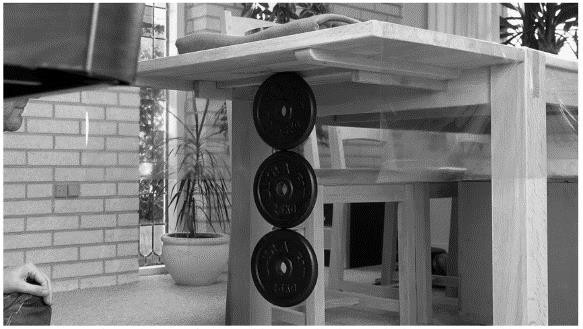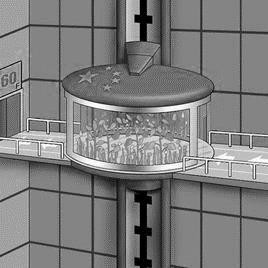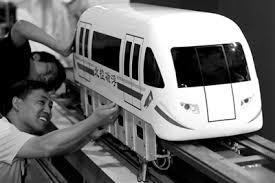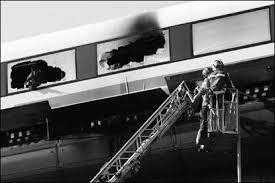第九章、永磁悬浮列车
MAST:A greatly energy-saving MAGLEVT
Author:Prof. (Ret.) Lehan WEI (魏乐汉)
of Shanghai Normal University, PRC.

Prof. Wei
MAST stands for Magnetic Array Suspension Train.
MAGLEVTT stands for Magnetically Levitated Train.
编者说明:有兴趣的读者可从网络上面查到魏乐汉教授 2016 年 12 月用中文撰写的《MAS 制永磁磁浮列车介绍》(专利名称:磁悬浮列车及其悬浮、导向和推进系统;专利号码:03114974.X)。魏老开章明义说道:「这里介绍的是一种由中国人发明的磁浮列车,是一种世界上还没有的永磁磁浮列车。」汉字图一至图五乃为编者增添。Figure 1 和 Figure 2 则是魏教授文原有。
1. Advantages of MAGLEVT
Because it is quick, energy-saving, safe, less field occupied and environment-friendly, MAGLEVT is an ideal land-vehicle. For example, when the distance is shorter than 3000km, MAGLEVT is the quickest one among all transports. As for energy consumption, for each passenger’s each kilometer, MAGLEVT is less than 1/2 to automobile, 1/4 to plane. For land occupation, MAGLEVT (elevated), just occupies 1/10-1/20 land to motor way. MAGLEVT not only reduces the traffic pressure, but also make any place the distance of which is shorter than 500 km a one-hour journey available to the passengers on board.
2. Present situation
At present, according to levitating fashions, there are mainly two kinds of high speed MAGLEVT: Electro-magnetic suspension (EMS), and electro-dynamics sus-pension (EDS).
The EMS was invented by the Germans, EDS was invented by the Americans. German is the leading country in the field of EMS. The MAGLEVT in Pudong District (浦东区) of Shanghai, is EMS-typed.
Japan is the leading country in the field of EDS, and has achieved the speed-record of 600 km/hr.
The disadvantage of EMS is that, first, there are a lot of levitating electro-magnets as well as guiding electro-magnets on the train, making the train very heavy. Secondly, its levitating height is very small—just 8-10mm. Therefore, high accuracy is required both for the track and the control system.
The disadvantages of EDS are that, first, low temperature superconducting magnets on the train are required. As a result, it requires a costful and heavy liquid helium refrigeration system. Secondly, the levitating force is related to the speed of EDS train. When the speed of train is lower than 150 km/h, the levitating force is not enough to support the weight of the train, thus wheels are necessary for taking off. Thirdly, large spray magnetic field exists in and round the train. As a result, those who are implanted pacemakers are not allowed to ride; mobile phones also cannot be used on EDS train.
Although there are MAGLEVT plane, high TC superconducting MAGLEVT and so on, yet they are not matured.
3. A new type of MAGLEVT: MAST
Eventually, an entirely new type of MAGLEVT has been invented by a retired Chinese Professor Lehan WEI(魏乐汉). It is called MAST.
Any transportation has three elements: support, propulsion and guidance. These three elements are different for different transportations, especially the supporting element. The above-mentioned three elements of MAST are introduced bellow.
(1) Levitation
The levitating mode of MAST is different from any other kind of MAGLEVTs presently used. Its levitating force comes from the magnetic reaction between permanent magnet array on train and permanent magnet array on rail. In simple words: Levitating force comes from both attraction and repulsion between permanent magnets. In strictly and theoretically words: levitating force comes from: magnetic flux lines are condensed laterally and stretched longitudinally.
These magnetic forces not only levitate the train in certain height, but also stop the train moves up and down. There is no similar advantage for any other kind of MAGLEVT. Because the magnet bars on train are acted by all magnet ranks on rail, as a result, the levitating force is proportional to magnet rank number N, and also proportional to magnet layer number M, and proportional to length L of magnet bar on train. In other words, the levitating force proportional to the products 0f N, M and L. So, it is a three- dimension enhancement system. As a result, the levitating force of MAST is at least three times greater than any kind of current MAGLEVTs.
In practical terms, 2 ranks (N=2) and 2 layers (M=2) are able to provide enough levitating force, not as many as in Figure 4. It has to be pointed out that in MAST, permanent magnets are adopted. Therefore, the levitation does not need energy consumption and refrigeration. Once the MAST is installed, no matter the train runs or not, in spite of day or night, the train is being levitated constantly as well as stably. And this levitation needs no control and no energy consumption.
(2) Propulsion
Magnetic gear wheel and magnetic rack are adopted acting as a propulsion system. This propulsion system within which there is no mechanical contact between wheel and rail is also invented by Professor Wei. Its function is equivalent to that: a mechanical gear is installed on train and a mechanical rack is installed on rail, with their magnetic lines of flux engaged. When the wheel is rotating, the train is driven forward or back.
(3) Guidance
At present stage, the mechanical guidance is adopted for MAST. There are guiding wheels fixed on both sides of the train rolling on the inner side wall of the U-shaped beam. Although being primitive, the mechanical guidance yet is simple and reliable. In addition, the guiding wheels do not bear the weight of the train, therefore, the friction resistance is very small. Especially in high speed, the guiding resistance may be neglected to the degree equal to air resistance.
4. Advantages of MAST
(1)Energy saving. The levitating function of MAST does not consume any energy. MAST just consumes little energy for guidance. MAST could be regarded as the most energy-saving vehicle in the world.
(2)Large levitating force. For EMS or EDS, the largest levitating force is less 150KN/m2 (15tons/m2). In comparison, for MAST, the levitating force can exceed 450 KN/m2. The loading ability of MAST can exceed 5 tons per meter carriage length, much larger than that of the wheel track train. As a result, MAST not only can load passengers but also can load goods.
(3)Passive levitating. The levitation needs not being controlled.
(4)Loading to deadweight ratio is large. For ordinary MAGLEVT, the loading to deadweight ratio is less than 1/3, but that of MAST can be more than 1/5.
(5)Great universality. MAST can be used both in high speed and low speed. It can run between cities or between city and its satellite towns, or as an urban vehicle.
(6)Low cost. Because the structure of MAST is simple, the costs of both train and rail are cheap. The rail costs about 150 million RMB per kilometer. The carriage costs about 0.4 million RMB per meter.
(7)Safety. Emitting no electromagnetic pollution, MAST is found to be environment- friendly.
Figure 1
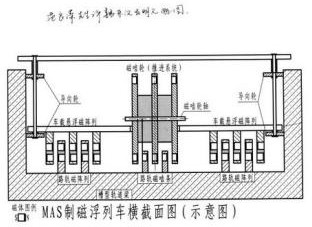
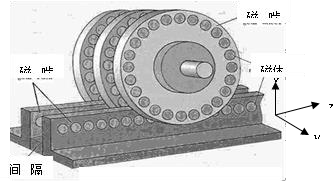
A performance comparison of various MAGLEVTs are given in the following tables.
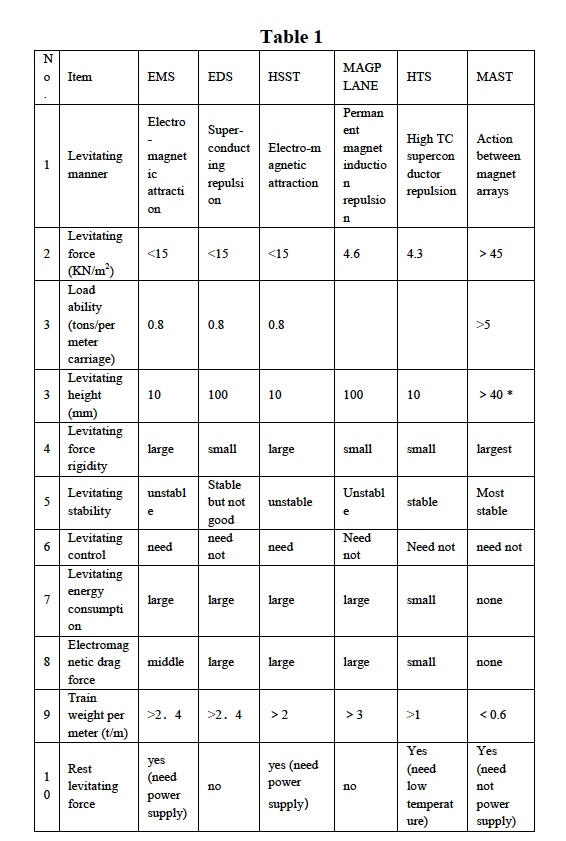
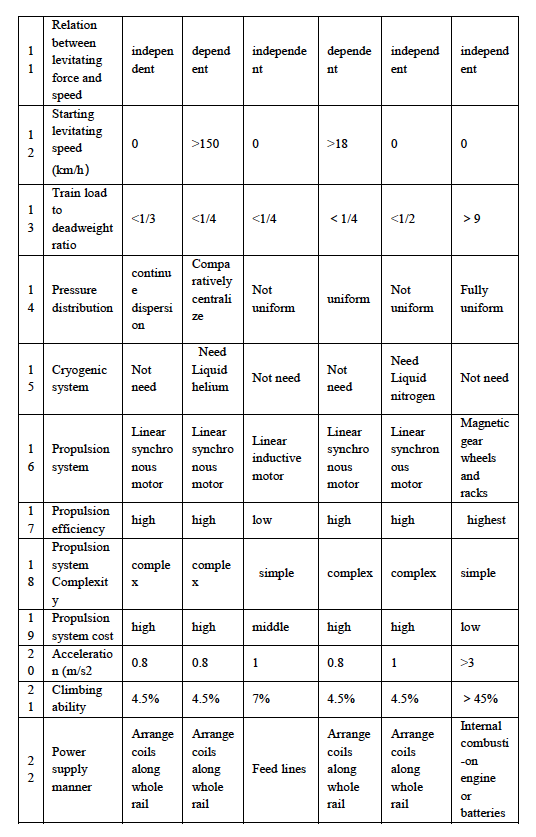
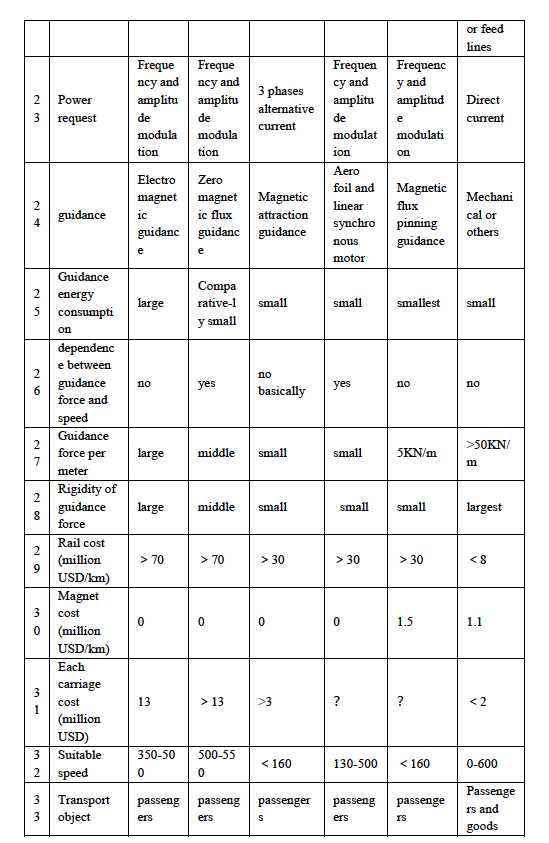
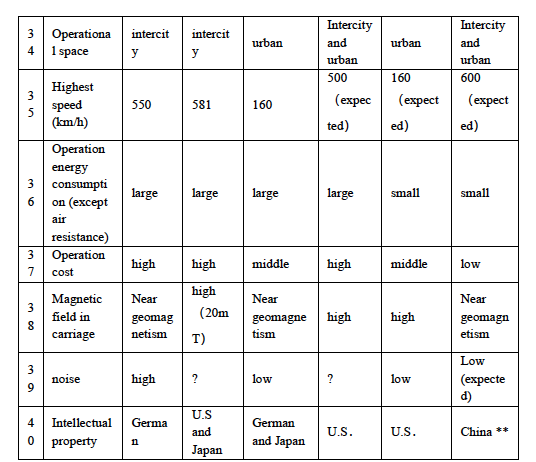
*The levitating height is not a problem anymore in MAST.
**Patent number: 03114974.x.
5. Present situation
We have developed three generations of MAST. They are called MAST-1, MAST-2 and MAST-3. The specification of them are shown in Table 2. MAST-4 is the next generation being constructed.
Table 2:Already developed MASTs
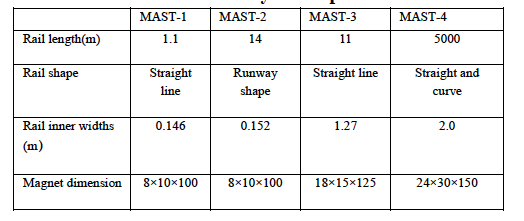
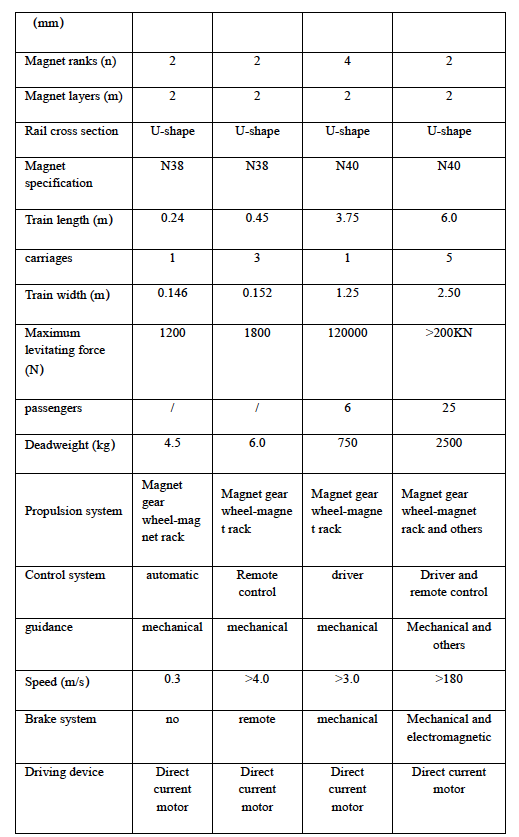

6. Answering questions
Question 1:
In MAST system, levitating and propelling magnets are paved on whole rail, does it need a lot of magnets and a lot of money?
Answer 1:
Not as so. In fact, the magnet quantity using for levitation is much less than people’s imagination. For example, when the levitating force is 40KN for each meter length of train (4t/m), then the required levitating magnets are 21.6 tons each kilometer rail. The price of NdFeB is 250 RMB/kg, therefore, the cost of levitating magnets is 5400000 RMB/km. The propelling magnets costs 1/3 of the levitating magnets. The costs of propelling magnets are 1800000 RMB/km (single track). The total cost of rail magnets is 7200000 RMB/Km. It just amounts 1/10 of the total rail cost.
Question 2:
Due to magnets being installed on the rail, do they cause magnetic environment pollution?
Answer 2:
No. From Figure 4, we can see that the magnetic flux lines are closed, they do not emit to ambient space. Figure 11 shows the B-d curve by actual measurement. Here B (in mT) is magnetic flux density and d is horizontal distance (in mm) from the levitating magnets.
In the following Figure 2, we can see that:
d=200mm,B=0.14mT;. d=300mm, B=0.1mT
(0.1mT=1 gauss, geomagnetic field=0.05mT=0.5gauss).
Question 3:
The magnets on rail would suffer rain, wind, snow, frost as well as high and low temperature, could they cause the magnets degraded?
Answer 3:
The magnetic flux density may decay about 5% in few hours after magnetization. Afterwards, the magnetic flux density almost keeps constant. The magnets need not be magnetize again in 100 years. High temperature can affect magnet properties, but even the NdFeB magnet of the lowest quality can suffer 80 °C. Therefore, ambient temperature does not affect magnet properties.
Question 4:
Can the magnets on rail attract ferromagnetic surrounding materials onto the rail?
Answer 4:
They cannot. Because the magnetic flux density out of the ―U‖-shape beam is as low as the geomagnetism, the levitating magnets cannot attract any ferromagnetic material into it. Some body suspects that levitating magnets could attract ferromagnetic dust in the air, and it is difficult to be removed. Our experiments indicate that it does not happen even if the track is 1 meter located near a cutting machine. In our experience, the ferromagnetic dust attracted by magnets is easy to be removed.
Question 5:
If a big bulk of iron, for example, as big as a fist, falls into the rail, would it cause an accident?
Answer 5:
Normally it will not happen, except someone throws it into the “U”-shape beam deliberatively. Being so, it is another matter. To say the least, if an enough big bulk of iron was thrown onto the rail and attracted by the magnets, it may cause an accident, but this accident only destroys the magnet array, the train will not run off the rail, and the passengers are still safe. By the way, if a stone or iron as big as a fist were thrown on motorway, it would cause more serious accident. Also, if there were a stick of wood as big as an arm were thrown on the track, the traditional wheel track train would run off the track.
7. Prospect
MAST-2 and MAST-3 have been exhibited on Industries Fair in Shanghai in 2003 and 2004 respectively. They attracted much attention from both the media and the public. After this, the inventor studies the MAST both in theory and experiments in further detail, and is sure that on the way to application, there exists no more barriers for theory, technique and engineering. Next step is to builda 3-5km long test line, as the last step before commercial operation. It needs 200-300 million RMB. The inventor is sure that after a couple of years, MAST will reach its commercialization stage. In the future, MAST will surely become a most important transport, and the significance of which is very great in social as well as economic terms.
Figure 2 (by hand) Stray magnetic field distribution

附录
永磁悬浮列车
360 百科
概念:永磁悬浮,即永久磁铁与轨道(由电磁轨道或导磁材料)相斥并保持在槽口中线可悬浮运行,电磁导向可实现零磨擦运行,机械向能接近零磨擦。永磁悬浮应用在交通优点是节能,它阻力系数约为滚动阻力 1/10,在 100 公里/ 小时运行速度内与汽车能耗比为 1:10。永磁悬浮交通与有轨交通有着一样的安全性、永磁悬浮高度是工作在某区间近似弹簧受力状态的一种自由稳定悬浮。电磁悬浮(如上海悬浮交通、日本超导悬浮列车方案)是不稳定悬浮。
要靠复杂控制技术实现悬浮,即使控制做得非常完善也不能保证永无保障,永不失磁,永磁悬浮能实现永不失磁。永磁悬浮交通设备结构就是电磁轨道与车体永磁条合一;永磁悬浮技术创新,可将磁悬浮原先的高技术悬浮、高制造成本、高精度实施,转变成一般性技术,低制造成本、低精度实施,易于普及推广。
原理:磁悬浮列车的原理并不深奥。它是运用磁铁「同性相斥,异性相吸」的性质,使磁铁具有抗拒地心引力的能力,即「磁性悬浮」。科学家将「磁性悬浮」这种原理运用在铁路运输系统上,使列车完全脱离轨道而悬浮行驶,成为「无轮」列车,时速可达几百公里以上。这就是所谓的「磁悬浮列车」,亦称之为「磁垫车」。
由于磁铁有同性相斥和异性相吸两种形式,故磁悬浮列车也有两种相应的形式:一种是利用磁铁同性相斥原理而设计的电磁运行系统的磁悬浮列车,它利用车上超导体电磁铁形成的磁场与轨道上线圈形成的磁场之间所产生的相斥力,使车体悬浮运行的铁路;另一种则是利用磁铁异性相吸原理而设计的电动力运行系统的磁悬浮列车,它是在车体底部及两侧倒转向上的顶部安装磁铁,在 T 形导轨的上方和伸臂部分下方分别设反作用板和感应钢板,控制电磁铁的电流,使电磁铁和导轨间保持10~15 毫米的间隙,并使导轨钢板的排斥力与车辆的重力平衡,从而使车体悬浮于车道的导轨面上运行。
磁悬浮列车与当今的高速列车相比,具有许多无可比拟的优点:由于磁悬浮列车是轨道上行驶,导轨与机车之间不存在任何实际的接触,成为「无轮」状态,故其几乎没有轮、轨之间的摩察,时速高达几百公里;磁悬浮列车可靠性大、维修简便、成本低,其能源消耗仅是汽车的一半、飞机的四分之一;噪音小,当磁悬浮列车时速达 300
公里以上时,噪声只有 65.6 分贝,仅相当于一个人大声地说话,比汽车驶过的声音还小;由于它以电为动力,在轨道沿线不会排放废气,无污染,是一种名副其实的绿色交通工具。
国产烧结钕铁硼永磁块。永磁悬浮电梯前景远大。
磁悬浮运载系模型。上海电磁式磁悬浮运载系短程观光版曾经发生火灾,电磁悬浮温度过高。
